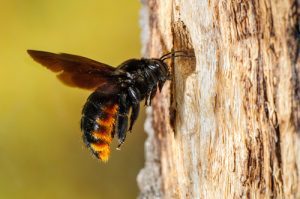Carpenter Bees Are Destroying Our Deck!
By Chris Williams on April 10, 2012.
Q. Last year we had a problem with carpenter bees nesting in our deck. Finally, the nesting stopped and I figured we were done with it. Well, they’re back! How much damage are they going to do to our deck and how can we stop this? My husband tried to plug up a couple of the holes, but they were soon opened up again.
A. Once she’s started a nest in wood, the female carpenter bee is persistent. Inside that circular opening, she has created several brood cells and she will provision each one with an egg and a ball of pollen for the larva to feed on when it hatches. The nest turns at a right angle just inside that circular opening and then extends along the length of the board for 4 to 6 inches.
 You don’t say whether your deck is new or old, and whether it has been treated or sealed. Carpenter bees prefer soft, weathered woods. Redwood and cedar are favorites. Decks, wooden deck furniture, cedar shingles, and wood sidings are common nest sites, as are roof eaves. Carpenter bees generally attack bare or weathered wood without paint. On roof soffits and fascia boards, they ignore the painted face side of the wood and instead tunnel on the unpainted backside. They will, however, attack wood that is stained or has only a very thin coating of paint. They will also tunnel wood that has been only lightly pressure-treated.
You don’t say whether your deck is new or old, and whether it has been treated or sealed. Carpenter bees prefer soft, weathered woods. Redwood and cedar are favorites. Decks, wooden deck furniture, cedar shingles, and wood sidings are common nest sites, as are roof eaves. Carpenter bees generally attack bare or weathered wood without paint. On roof soffits and fascia boards, they ignore the painted face side of the wood and instead tunnel on the unpainted backside. They will, however, attack wood that is stained or has only a very thin coating of paint. They will also tunnel wood that has been only lightly pressure-treated.
Carpenter bees are mostly a nuisance and cosmetic pest; they rarely do any structural damage. However, damage can become serious over time when carpenter bees nest in groups, or reinfest old nest sites the following year, or if woodpeckers attack the wood trying to reach the carpenter bee larvae inside. The amount of damage that can occur is proportional to the amount of suitable wood available for attack and the number of pairs nesting in the same site. Often, several pairs of bees will nest near each other if they have found a good location. And bees usually return to nest in the same area the following year. Instead of beginning a new nest, a returning female may reuse an old nest by extending the burrow, as far as several feet.
Assuming that carpenter bees are also not nesting along your roof eaves or in siding, the dime-sized nest holes in your deck are the main concern, along with the annoyance of being dive-bombed by large noisy bees when you try to use your deck. To ease your mind though, the male bee that guards the nest cannot sting although he will do his best to scare you away. The female carpenter bee can sting but she is very docile and very busy. Nesting activity is limited to a short period in the spring.
A pest control company can treat the nest galleries to kill the bees inside and any returning females. An insecticide treatment of surrounding wood will repel any bees planning to nest there. As a final protective step, you should paint or varnish your deck to eliminate bee nesting next year.